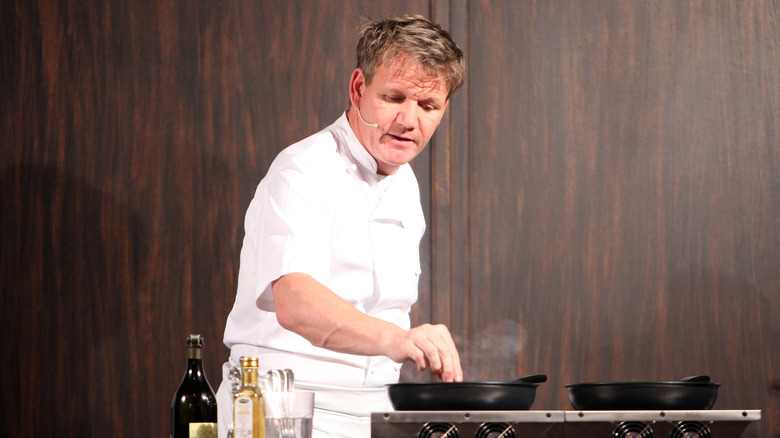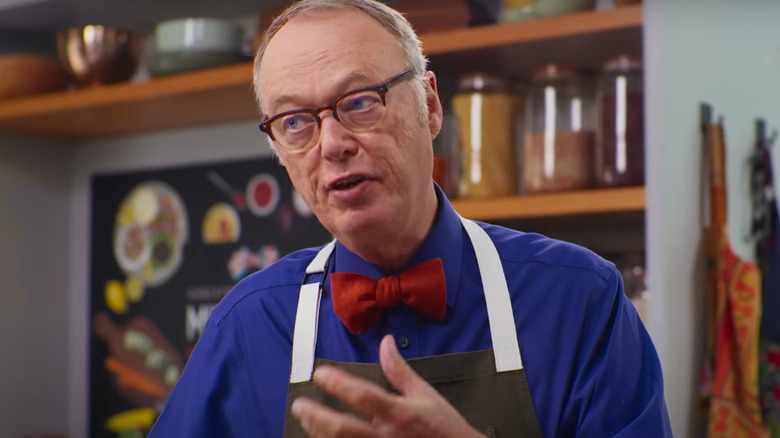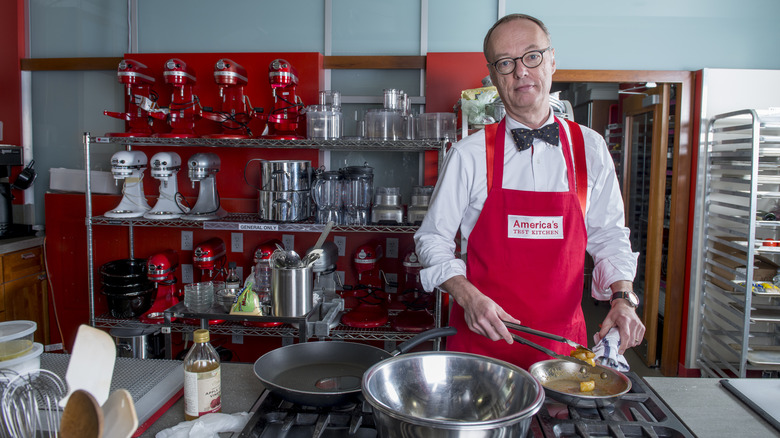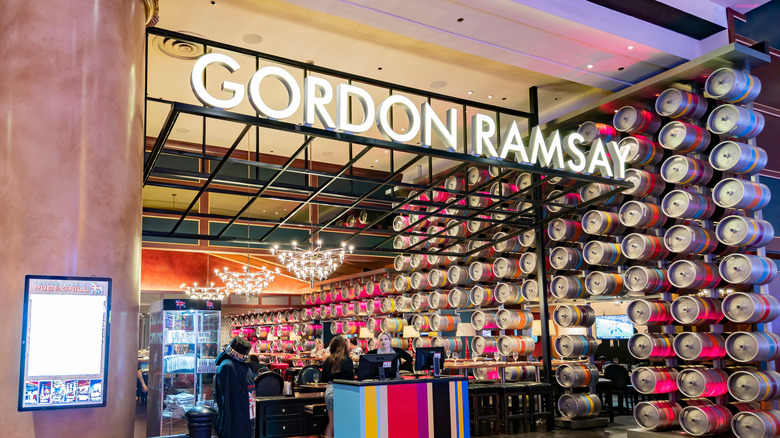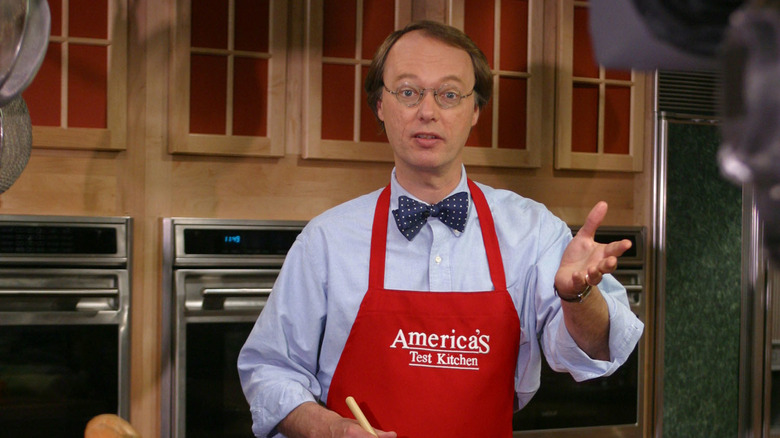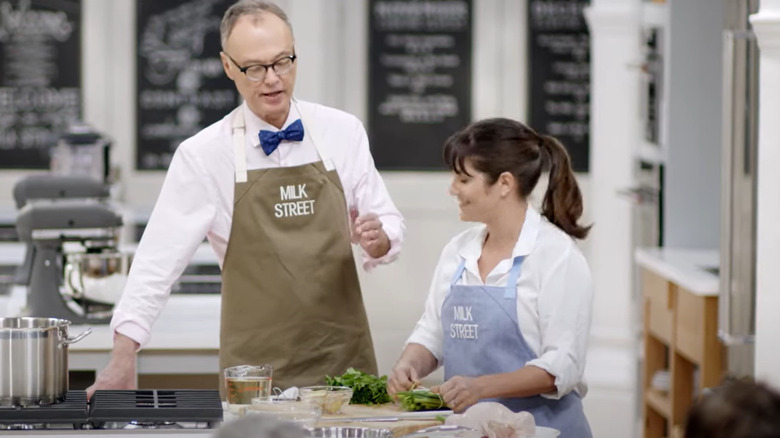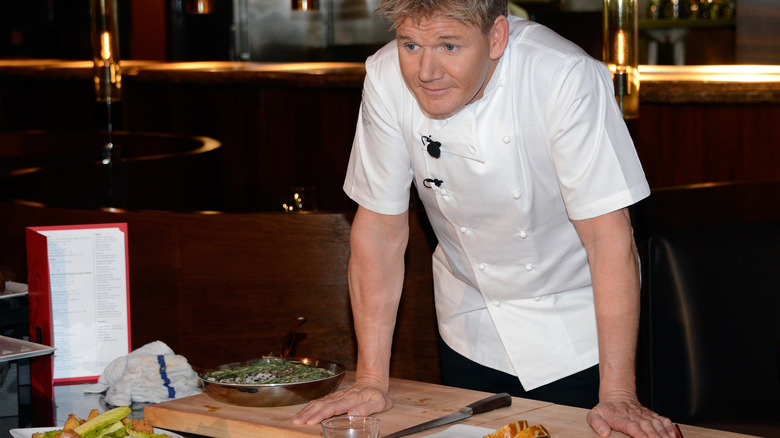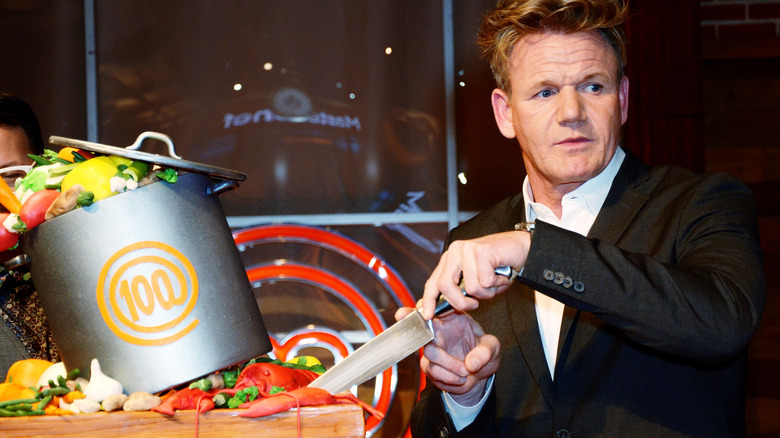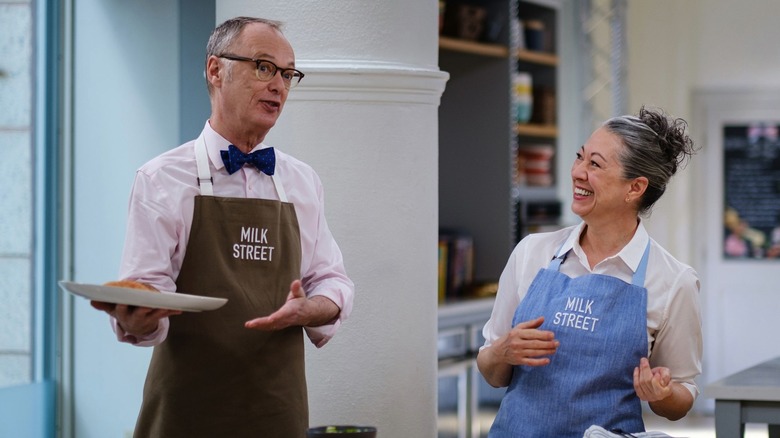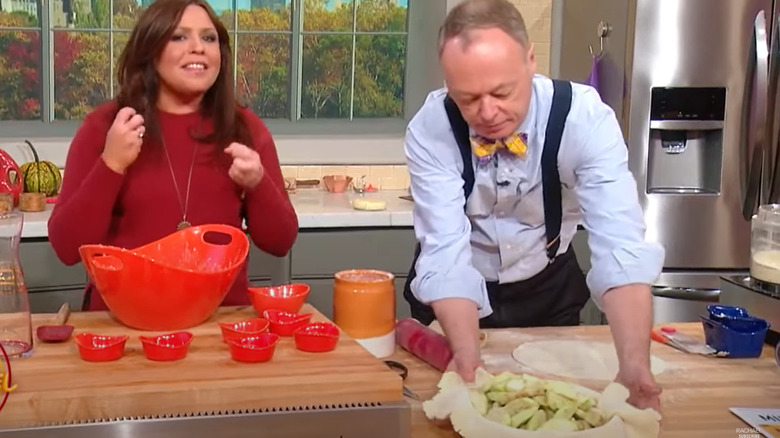Christopher Kimball's Cooking Style Vs Gordon Ramsay's: Everything You Need To Know
Christopher Kimball and Gordon Ramsay are iconic figures in the culinary world, each with a distinct approach. They might be among the most influential celebrity chefs ever, but how does this impact their food? To understand how Christopher Kimball's cooking style compares to Gordon Ramsay's, it's worth starting with some background information about them.
Kimball is best known as the founder of Cook's Illustrated magazine and the cooking show "America's Test Kitchen." He also founded Milk Street, another cooking media company. Kimball is celebrated for his meticulous approach to cooking, emphasizing precise techniques and numerous variations of recipes to determine the best methods and ingredients. You might recognize him for his signature bow tie and glasses.
Ramsay is a renowned British chef, restaurateur, and television personality. He gained fame for his fiery temperament and no-nonsense approach to cooking on various television shows, including "Hell's Kitchen" and "Kitchen Nightmares." Ramsay is celebrated for his culinary expertise, having earned multiple Michelin stars for his restaurants around the world.
We delved deep into Kimball and Ramsay's cooking styles to see where they differ and converge. They might be two very different people, yet there are places where their styles overlap, as well as many where they don't.
Gordon Ramsay's cooking style is inspired by classic French cuisine
Classic French cuisine is an encompassing term for the traditional cooking techniques, ingredients, and dishes that originated in France. While it might be a Eurocentric opinion, some people claim that all good cooking has its basis in French technique. It emphasizes high-quality ingredients, precise cooking methods, and meticulous presentation. Some key characteristics of classic French cuisine include rich sauces, culinary techniques such as sous-vide and sauteeing, and a focus on fresh seasonal produce.
Gordon Ramsay's cooking style has been significantly influenced by this approach. Training in Paris with Michelin-starred chefs Guy Savoy and Joël Robuchon gave him a strong foundation in French cooking techniques and principles. This stint highlighted the importance of precision, attention to detail, and the pursuit of excellence in the kitchen, all of which are important aspects of classic French cuisine.
In his cooking and restaurants, Ramsay often incorporates elements of French culinary tradition, such as refined sauces, elegant plating, and respect for fine ingredients. While he's known for his bold and innovative approach to cooking, Ramsay's appreciation for the fundamentals of French cuisine is evident in many of his dishes. His training and experiences in France have undoubtedly played a significant role in shaping his culinary style and philosophy.
Christopher Kimball's current cooking style is inspired by a wider range of global cuisines
Christopher Kimball's current cooking style, as showcased in his work at Milk Street, draws inspiration from a range of global flavors. Unlike traditional French cuisine which often focuses on a more limited repertoire of techniques and ingredients, Kimball's approach at Milk Street more broadly explores international flavors and cooking methods. According to Kimball, it's not about appropriating other nations' cuisines, but exploring what the world has to offer and experimenting with it in different ways.
Rather than copying traditional global dishes, Kimball and his team at Milk Street reinterpret and adapt flavors and techniques from various culinary traditions to suit American home cooks. This involves experimenting with spices, herbs, and cooking techniques from regions around the world and integrating them into everyday cooking.
For example, Kimball might incorporate Korean fermented chili paste, gochujang, into an egg salad, or subvert a classic chicken soup by adding Thai-inspired spices and aromatics. In doing so, he introduces his audience to new and exciting flavor profiles while providing practical recipes and techniques that are still approachable.
Christopher Kimball's cooking style used to be focused on American food
Christopher Kimball's earlier work, particularly with "America's Test Kitchen" and Cook's Illustrated, was primarily focused on American food. He was beloved in these roles and some people say "America's Test Kitchen" hasn't been the same since Kimball left. Through these platforms, Kimball and his teams meticulously explored and perfected classic American dishes, as well as popular comfort foods and regional specialties from across the United States.
Kimball also aimed to unravel the science behind cooking and recipe development. His work at "America's Test Kitchen" and Cook's Illustrated involved exhaustive testing of recipes, equipment, and ingredients, to bring foolproof methods and trusted culinary advice to home cooks.
Kimball's focus on American cuisine spanned all kinds of dishes, from iconic favorites like apple pie and fried chicken to regional gems like New England clam chowder and Southern-style barbecue. He delved deep into the history and traditions behind these foods but also sought to modernize recipes and techniques to suit contemporary tastes and cooking environments.
His approach to American food called for readily available ingredients and practical cooking methods. This made cooking less daunting and he undoubtedly taught many people to cook. Although he's now moved on to using global flavors, his earlier work with American food has left a lasting impact on home cooking in the U.S.
Gordon Ramsay sometimes focuses on traditional British food
Christopher Kimball might have spent a long time focusing on American food, but Gordon Ramsay has looked to his heritage by featuring British cooking in his repertoire. Yes, Ramsay might be trained in French cooking and focus on French cuisine at some of his restaurants. However, he frequently celebrates his heritage by showcasing English cuisine in his cookbooks, television shows, and online recipes.
Ramsay pays homage to traditional British dishes, offering his interpretations of beloved classics such as Yorkshire pudding, bangers and mash, and shepherd's pie. You'll notice Ramsay's signature flair for elevating simple ingredients in these British favorites. Whether it's using techniques to perfect the crispiness of Yorkshire puddings or adding smoked salt, mustard, and chives to elevate his mashed potatoes, Ramsay's approach combines an appreciation for tradition with a touch of innovation.
While Ramsay and Kimball might have drawn inspiration from different cooking styles, it all goes back to their individual heritage. Ramsay has spent time working on British favorites, whereas Kimball spent years cooking and perfecting American cuisine. It's at once a difference and a similarity.
Gordon Ramsay's cooking style often veers into fine dining territory
Christopher Kimball has dedicated his career to serving the needs of home cooks, while Gordon Ramsay's cooking style veers into the realm of fine dining. Ramsay doesn't just shout at people on TV, he also has Michelin-starred restaurants around the world. And, yes, those prestigious stars really are awarded by the tire company.
Ramsay's restaurant empire includes establishments that range from upscale dining to more casual eateries, but his flagship Restaurant Gordon Ramsay holds an impressive three Michelin stars, a distinction it has maintained for 23 years. And, that's quite a feat — only 144 restaurants worldwide have three Michelin stars.
If you've seen Ramsay's shows, you'll know he can get pretty caught up in the details. His approach to cooking at his fine dining establishments reflects his exacting standards and commitment to excellent food. His menus include meticulously crafted dishes that often feature premium ingredients and intricate techniques. At Ramsay's fine dining restaurants, you can expect impeccable service, elegant presentation, and unforgettable dishes.
Both Gordon Ramsay and Christopher Kimball cover the basics of home cooking
Despite Gordon Ramsay's background in fine dining, he also caters to the needs of home cooks through his cookbooks, television shows, and online recipes. While Ramsay is celebrated for his Michelin-starred restaurants and expertise in haute cuisine, he has also demonstrated a commitment to making cooking accessible and approachable for home cooks.
On shows like "Kitchen Nightmares," Ramsay offers guidance and support to struggling restaurateurs, but he also shares practical cooking advice and recipes tailored to home cooks on programs like "Gordon Ramsay's Home Cooking." In his cookbooks and online content, Ramsay provides people with a range of recipes spanning from quick and easy weeknight meals to more elaborate dishes suitable for special occasions.
This focus on home cooking and making culinary skills accessible to a wide audience is something Gordon Ramsay and Christopher Kimball have in common. Kimball has created thousands of recipes for "America's Test Kitchen," Cook's Illustrated, and now Milk Street, all with an emphasis on cooking at home. The chefs' backgrounds and culinary styles might differ, but the two have dedicated significant portions of their careers to giving home cooks the knowledge and techniques they need to prepare delicious meals in their own kitchens.
Christopher Kimball's cooking style relies on bold flavors
You can expect a bold and vibrant approach to flavor from Christopher Kimball's current cooking style at Milk Street. His recipes start with a base of assertive flavors from around the world. One of the hallmarks of Kimball's cooking philosophy at Milk Street is the use of flavorful ingredients such as scallions, ginger, garlic, chili peppers, and aromatic spices to create depth and complexity. These ingredients serve as the foundation for many of his recipes, infusing them with layers of flavor from the outset.
This means he (and anyone who cooks his recipes) doesn't have to rely solely on time-intensive cooking techniques to develop flavor. Instead, Kimball combines vibrant, strong flavors and doesn't shy away from using large quantities of fresh herbs or other zingy ingredients. The resulting dishes are aromatic and amazingly tasty, ultimately reflecting Kimball's embrace of global food influences.
Gordon Ramsay uses simple ingredients and sometimes longer cooking times to build flavor
Gordon Ramsay's cooking style often revolves around using simple, high-quality ingredients and letting them shine through longer cooking times to build depth and flavor. While he has some quick recipes, Ramsay also emphasizes the importance of simplicity and patience. It's not unusual for Ramsay to show off the natural flavors of ingredients by allowing them to slowly develop and meld together over time. This might involve techniques such as braising, stewing, or slow-roasting, where ingredients are cooked gently over low heat for an extended period. Through this process, flavors have the opportunity to deepen and intensify, resulting in rich and nuanced dishes.
Another aspect Ramsay often emphasizes is the importance of proper seasoning throughout the cooking process. By adding salt, pepper, herbs, and other seasonings at various stages, Ramsay makes sure that each component of the dish gives everything it can. While Ramsay's approach to building flavor may differ from Kimball's bold, vibrant style at Milk Street, both chefs share a commitment to using simple, high-quality ingredients and making them come to life through thoughtful cooking techniques.
Both Gordon Ramsay and Christopher Kimball's recipes generally use easy-to-find ingredients
One of the ways that Gordon Ramsay and Christopher Kimball make their recipes more accessible for the average cook is by using easy-to-find ingredients. They understand that convenience is key for home cooks, so they create recipes with ingredients usually found in a well-stocked grocery store. For the most part, you shouldn't have to look beyond mainstream supermarkets to follow their recipes, avoiding the need to visit specialty stores.
In his book, "Ramsay in 10," the chef highlights recipes that are quick to make and specifically focus on easy-to-find items, so that people don't get put off due to long, complicated ingredient lists. Kimball's cooking for "America's Test Kitchen" was often the same, as he noted that most people have little interest in looking beyond their local supermarket when making meals.
It's worth noting that Kimball occasionally incorporates ingredients from global culinary traditions that you might not find in mainstream supermarkets, especially outside big cities. However, you can easily get them from specialty or international food stores. It may require a bit of extra effort to track them down, but it adds a novel element to the process.
Gordon Ramsay is known for his fiery approach in the kitchen
Gordon Ramsay has cultivated a reputation for his fiery, intense demeanor in the kitchen. You will have seen him shouting and cursing on shows such as "Hell's Kitchen" and "Kitchen Nightmares." On screen, Ramsay is often demanding, assertive, and quick to express his dissatisfaction with subpar performance or food quality. His sharp tongue and colorful language have become iconic elements of his television persona, earning him both fans and critics.
But don't believe everything you see on TV. Ramsay's on-screen persona is largely a product of entertainment and has been exaggerated for dramatic effect. Behind the scenes, Ramsay is known to be quite different from his television persona. In reality, he is widely regarded as a dedicated and passionate chef who cares deeply about his craft and the success of those he mentors. He's a dedicated family man and often raises money for charity. Ramsay has shown a more nurturing and supportive side in his interactions with aspiring chefs on shows like "MasterChef" and "MasterChef Junior," where he offers constructive criticism and guidance to help contestants improve their skills.
Both Gordon Ramsay and Christopher Kimball's recipes are often quick and easy
Gordon Ramsay and Christopher Kimball both offer many recipes that are quick and easy to prepare, sharing the joy of cooking with as wide an audience as possible. So, you can find delicious yet achievable meals from Ramsay and Kimball, no matter your skill level or how much time you have to cook.
Kimball focuses on developing recipes that are practical and approachable. You'll often notice they are full of straightforward techniques and readily available ingredients, so they're suitable for cooks of all experience levels. Kimball's goal is to empower home cooks with the confidence and skills needed to create delicious meals without feeling overwhelmed by complex instructions.
Similarly, Gordon Ramsay has released books and online recipes specifically tailored to quick and easy dishes, as well as recipes designed for beginner cooks. Despite his background in fine dining and haute cuisine, Ramsay understands the importance of providing practical solutions for busy individuals and novice cooks. His recipes often prioritize simplicity, using minimal ingredients and straightforward cooking methods while still being tasty.
Christopher Kimball and Gordon Ramsay have both ventured into dessert recipes
You might think of Gordon Ramsay as someone who makes savory food, whether it's classic British dishes or French-inspired haute cuisine. And, maybe Christopher Kimball's recipes on "America's Test Kitchen" taught you to poach eggs or cook a Thanksgiving turkey. But, if you think their cooking styles begin and end with savory food, then you're missing out on part of the story.
Both Kimball and Ramsay have ventured into the sweet world of desserts in their work. Of course, Ramsay serves desserts at his restaurants, but these are likely created and executed by pastry chefs. Still, he learned the way of sweet dishes during his professional training. You'll find plenty of desserts in his cookbooks and in the selections of recipes he posts online. From pies and galettes to British classics such as sticky toffee pudding, Ramsay has crafted all kinds of treats for your sweet tooth.
Naturally, Kimball has covered many classic American desserts, such as apple pie. However, there's often a more global bent to the dessert recipes at Milk Street. For instance, cardamom features heavily in the banana bread, and you'll find Turkish date-stuffed cookies and Brazilian-inspired carrot cake among the selection.

